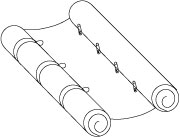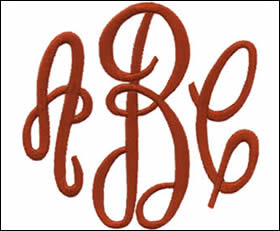Check out this fabulous article we found over at Dummies.com by Cheryl Fall. Dummies has how to articles on just about everything. See what you can find!
Machine Quilting Tips and Tricks
If you have chosen to machine quilt your project, you need to prepare your machine for the chore at hand. Each machine quilting technique requires a different type of presser foot and machine setting, so read through the following information carefully.
If you have
pin basted your quilt together, you must remove the safety pins as you approach them. Do not, under any circumstances, attempt to
stitch over a safety pin. Not only does stitching over them make them difficult to remove, but it's dangerous! You could easily break your
needle, sending a fragment of the needle into your eye.
Preparing large-size projects
If you are quilting a large project, such as a bed quilt, be sure you have a large surface to the rear and to the left of your machine to help you support the
weight of the quilt. These large-size projects are very heavy and can easily pull your machine right off the table and onto the floor!
Prepare any quilt larger than 36 inches x 36 inches for quilting by rolling it as follows.
Lay the basted quilt on the floor and roll the two sides towards the center, leaving a 12-inch swath of quilt unrolled, as shown in Figure 1. This is where you will begin machine quilting. Secure the rolls with safety pins or bicycle clips.
Figure 1: Rolling and securing the quilt.
You can find bicycle clips at the sporting goods store and at some quilting stores. Bicycle clips are flexible metal rings with a small opening. They hold your pants leg against your body while cycling so that your pants don't get caught in the bicycle
chain.
Bicycle clips function the same way on a quilt. Just think of the rolled edges of the quilt as the "leg" and put the clip over this rolled leg, holding it securely in place.
Using straight-line quilting for the beginner
Straight-line quilting is the easiest form of machine quilting. The results are always good, and it's quick, too!
Begin by inserting an even-feed presser foot in your machine, as shown in Figure 2. These presser feet are also known as walking feet. If your machine did not come with an even-feed foot, make a trip to the
sewing center to get one. Bring your machine's manual with you so the clerk can help you find the right foot for your model.
An even-feed foot makes machine quilting smoother and pucker-free because it feeds the layers of the quilt through the machine evenly. Without it, the feed dogs (those teeth under the needle) will only feed the bottom layer of fabric through the machine, leaving the batting and top layers open to puckering because they're not being fed through the machine at the same rate.
To start machine stitching:
1.
Thread the top of the machine with a coordinating shade of all-purpose thread.
If you would like the stitching to be invisible, use clear
nylon monofilament as your top thread.
2. Load the
bobbin with all-purpose thread in a color to match or coordinate with your backing fabric.
3. Set the stitch length on the machine at 6 to 10 stitches per inch.
4. Place the unrolled center area of the quilt in the machine and take one stitch.
5. With the needle up, stop and raise the presser foot. Pull the top thread
tail so that the bobbin thread tail comes up through the hole in the stitch you made in Step 4.
You now have both tails on top of the quilt.
6. Lower the presser foot and begin stitching by taking two stitches and then stopping.
7. Put your machine in reverse and take two stitches backward to secure the thread.
You are now ready to stitch your quilt.
8. Continue stitching normally (without reversing) along your marked lines, in-the-ditch, or however you have decided to quilt your project.
9. When you get to a corner that needs to be
turned, lower the needle into the fabric and raise the presser foot. Pivot the quilt in the other direction and lower the presser foot again. Continue stitching.
10. When you reach a spot where you need to stop stitching, take two stitches backward to secure the thread, just as in Step 7.
Remember, you need to secure the thread at the beginning and end every time, or you run the risk of the stitching coming undone at these starting and stopping points, resulting in an unsightly 1/4 inch or so that is unstitched.
After you finish quilting the area you unrolled, remove the project from the machine and unroll the sides to expose an unquilted area. Continue stitching until you have quilted the entire quilt.
Choosing free-motion machine quilting for advanced projects
Free-motion machine quilting requires some practice to master, but the following description will give you a brief introduction. Plenty of books are available devoted entirely to this subject.
Free-motion quilting is beautiful for fancy quilting
patterns, with decorative possibilities limited only by your imagination. You can use it to create graceful curved designs and floral patterns, as well as the basis for stipple quilting by machine.
To do free-motion quilting, you need a special presser foot called a darning or free-motion foot. This type of foot has a
rounded toe that travels just above the surface of the fabric, as shown in Figure 3.
Because you feed the quilt through the machine manually, free-motion quilting requires you to disengage your machine's feed dogs:
- On some machines, you disengage the feed dogs by turning a knob, which lowers them out of position.
- On other machines (especially older models), you don't lower the feed dogs to disengage them. Instead, you cover them with a metal or plastic plate. You will find this plate in your machine's bag of tricks.
Refer to your machine's manual to see how yours works.
With free-motion quilting, you do not need to adjust the length of the straight-stitch on your machine at all. The speed at which you are sewing combined with the speed at which you move the quilt around under the needle determines the stitch length. This is why practice is so important before attempting a large project in free-motion quilting.
After inserting the darning foot and disengaging the feed dogs, thread your machine and bobbin as you would for straight-line quilting. Place the quilt under the presser foot with one hand positioned on each side of the quilt, 2 inches or so from the presser foot. Use your hands to guide the quilt in the necessary direction under the darning foot.
If your fingers feel dry, or if you are having trouble moving the quilt under the machine because your fingers are sliding on the fabric, cover the first and index finger of each hand (four fingers in all) with a rubber fingertip from the office supply store.
Slowly begin stitching, taking two or three stitches in the same spot to secure the thread at the beginning. As you stitch, move the quilt, guiding it with your two hands, so that the needle follows your marked quilting lines or designs. Keeping the machine at a steady speed, move the fabric slowly and smoothly so you don't end up with gaps or overly
long stitches. Slow and steady is the
key here!
Free-motion machine quilting takes some time to master. Start on small projects, such as pillows, placemats, or wallhangings, before progressing to larger projects. Stipple quilting is a great first-time use for free-motion quilting because you are not required to follow a set pattern. Instead, you learn to maneuver the project under the darning foot and get some much-needed experience.




















